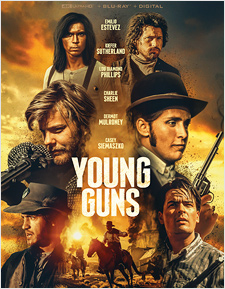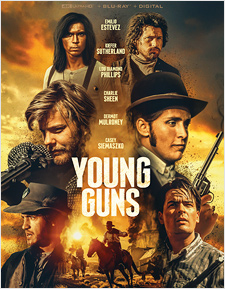Young Guns: 35th Anniversary Edition (4K UHD Review)

Director
Christopher CainRelease Date(s)
1988 (December 5, 2023)Studio(s)
Morgan Creek Productions/20th Century Fox/Vestron International (Lionsgate Home Entertainment)- Film/Program Grade: B-
- Video Grade: A-
- Audio Grade: A
- Extras Grade: B+
Review
The year is 1878, the place Lincoln County in the New Mexico Territory. English rancher and merchant John Tunstall (Terence Stamp) is locked in a fierce competition with rival Lawrence Murphy (Jack Palance), who’s using his money and influence to bribe the local attorneys, land speculators, and public officials. To help even the odds, Tunstall has taken in a motley bunch of young drifters and gunmen to work his ranch and provide protection, among them Doc Scurlock (Kiefer Sutherland), Jose Chavez y Chavez (Lou Diamond Phillips), Dick Brewer (Charlie Sheen), “Dirty” Steve Stephens (Dermot Mulroney), and Charlie Bowdre (Casey Siemaszko). Into this mix comes young William H. Bonney (Emilio Estevez), who joins Tunstall’s “Regulators” just as things get heated with Murphy and his gang. Tunstall sees in Bonney a quality that he admires, and he treats the young man with respect. But when Murphy’s gang kills Tunstall, Bonney finds a new quality in himself… that of a cold-blooded killer… and soon leads the Regulators on a bloody campaign of vengeance as the one and only “Billy the Kid.”
Directed by Christopher Cain (That Was Then, This Is Now, Pure Country) and the first project of Joe Roth’s Morgan Creek Productions, Young Guns is a fascinating movie western, one of those titles that you either love or not. The film doesn’t have a great deal of style beyond the frequent use of slow motion, and it struggles to hang on to the momentum it builds. The cast is a who’s who of 1980s male ‘Brat Pack’ actors—even the ones who don’t actually star here either visited the set (Rob Lowe, Judd Nelson), made uncredited cameos (Tom Cruise, Jon Bon Jovi), or were offered parts (Sean Penn, Patrick Swayze). But apart from Estevez, Sutherland, and Phillips, who each manage to make their roles memorable with genuine zeal and/or earnestness, the performances are somewhat uneven. And the score is a glossy and pure 80s piece of synth rock by Anthony Marinelli that’s entertaining as hell, but occasionally feels like an odd fit. (In fact, the film’s humor itself occasionally feels like an odd fit.) And yet… the more you dig into Young Guns, the more interesting it becomes.
While watching it, you think… “Oh, this film wants to be Tombstone.” But then you realize that Tombstone came out five years later. In fact, it’s fair to say that Young Guns is the film that reinvigorated Hollywood’s interest in the western genre (it was followed in short order by Quigley Down Under, Dances with Wolves, City Slickers, Unforgiven, Tombstone, Maverick, Wyatt Earp, The Quick and the Dead, and Wild Bill). It just so happens that for all its bluster, Young Guns is one of the most historically accurate retellings of the Billy the Kid mythos to date, a story previously fictionalized in Andrew McLaglen’s Chisum (1970), starring John Wayne (whose son Patrick appears here), and Sam Peckinpah’s Pat Garrett and Billy the Kid (1973). Here’s an interesting bit of trivia: This film’s set was run, at least in part, by members of the Oakland chapter of the Hell’s Angels. It turns out that Marinelli was an eleventh-hour replacement for original composer James Horner, whose Irish string score was deemed “not rock and roll enough” and too ill-fitting with the film’s humor. And the cast is lent a bit of genuine gravitas by the presence of no less than Terence Stamp, Jack Palance, Terry O’Quinn, and Brian Keith.
Young Guns was shot on 35 mm photochemical film by cinematographer Dean Semler (who won an Academy Award for Dances with Wolves two years later) using Panavision Panaflex cameras with Panavision spherical lenses, and it was finished at the 1.85:1 flat aspect ratio for theaters. For its 35th anniversary, Lionsgate has prepared a new 4K scan of the original camera negative, completed a digital restoration, and graded the film for high dynamic range (both Dolby Vision and HDR10 are available options—and a tip of the hat to Lionsgate for including the Dolby Vision/Atmos logo tease when you first insert the disc). The resulting 4K image is quite good looking, once you get past the film’s opening credits, which are heavily digitally processed. Fine detail and overall resolution are very pleasing, and a big improvement over the previous Blu-ray release, particularly in brighter daylight scenes. Contrasts are strong, with generally deep blacks and well-detailed shadows, though some shots are a little gray looking given the amount dust in the air on location. Highlights are bold throughout. Colors are a bit muted given the period western setting, but they’re always accurate and natural looking. The fine texturing of wood, foliage, and clothing is mostly excellent. Photochemical grain is light-medium to medium, but organic at all times. This isn’t an eye-candy image by any means, but it certainly represents this film looking its very best.
Lionsgate has provided two audio options on both the 4K UHD and Blu-ray discs here, including the original English 2.0 stereo in PCM format (sourced from the LaserDisc release to ensure its theatrical accuracy) as well as a new English Dolby Atmos mix (and this was checked against the PCM to ensure that nothing untoward was added or changed). Like the 4K image, the Atmos experience isn’t quite a sonic tour de force, but it is pleasingly smooth and robust, and it impresses with all kinds of little subtle atmospherics even in quieter scenes. When Murphy and his posse ride up to Tunstall’s ranch, for example, you can hear the sound of clopping hoofsteps, whinnying horses, and jangling spurs all around, not to mention the soft whispering breeze. Dialogue is full and clean sounding, while the score—by turns lively and edgy—utilizes the entire soundstage. When the gunplay does break out, there’s plenty of low-end bluster to give every shot a crisp report and every impact pleasing and muscular oomph. And while some will prefer the theatrical stereo audio, the best thing about this Atmos mix is that it respects the character of that original experience. Note that optional subtitles are available here in English, English SDH, and Spanish.
Lionsgate’s new 4K release (and the remastered Blu-ray included with it in the package) both include the following special features:
- Audio Commentary with Lou Diamond Phillips, Dermot Mulroney, and Casey Siemaszko
- How the West Was Wild: Making Young Guns (4K – 35:53)
- Billy the Kid: The True Story (Upsampled SD – 32:17)
- Teaser Trailer (4K – 1:16)
- Theatrical Trailer (HD – 1:28)
The commentary carries over from the 2003 Special Edition DVD. It features a few interesting behind the scenes stories, particularly from Phillips, but there are long periods where the actors fall silent. Billy the Kid: The True Story meanwhile was produced in 2005 and appeared on the 2007 Blu-ray. It’s an informative piece featuring several experts who impart the real historical details. The film’s teaser and theatrical trailers are also included.
But the best extra here is all-new, created just for this 4K release. How the West Was Wild: Making Young Guns was produced by our old friend Cliff Stephenson and features new interviews with Cain and screenwriter John Fusco (who grounds the piece), cast members Phillips, Mulroney, Siemaszko, and Geoffery Blake, director’s assistant Wendall Thomas, and composer Anthony Marinelli. Three other cast members—Estevez, Sutherland, and Sheen—are represented by vintage interview material (their participation in new interviews was sadly derailed by the SAG-AFTRA strike). But you also get to see rare screen test footage, film outtakes, and behind-the-scenes production video. Best of all, you get to hear clips of Horner’s original unused score, played over actual film footage (and compared to the Marinelli score, so you can fully appreciate the tonal differences). If you’re a true fan of Young Guns, this thirty-minute piece is worth the price of the disc all by itself.
Of course, you also get a Digital Copy code on a paper insert. And the disc is available in two different versions: A 4K wide release in Amaray packaging and a Best Buy-exclusive 4K Steelbook (probably one of the last ever) that features custom art by illustrator Grzegorz Domaradzki, as well as exclusive art cards.
Somehow, and against all odds, Young Guns became a box office hit in 1988 and has not only endured, it’s become a cult favorite. And though the film itself is somewhat uneven, it certainly has its charms, not the least of which is a playful performance by Emilio Estavez, who brings a great deal of fun to the role of Billy the Kid. Enthusiasts will be pleased to know that Lionsgate has produced a terrific (and long overdue) 4K Ultra HD release that delivers fine A/V quality and a nice mix of both new and legacy bonus content. It’s definitely recommended for fans.
- Bill Hunt
(You can follow Bill on social media at these links: Twitter and Facebook)

